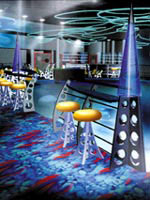Clubbers guide to interior design
James Knight looks at the issues that have to be addressed by designers when creating nightclub interiors

The opening of Pacha London aims to bring a new opulence to the capital’s club scene. The interiors for the club are ambitious, and, at a cost of £1.3m, not cheap.
The care and attention lavished on nightclub design goes beyond the cosmetic. There is a host of practical considerations that need taking into account at the conceptual stage. Health and safety laws, fire regulations, licensing laws, noise levels and increased likelihood of recreational drug use are all factors that govern nightclub layout and ambience.
‘You start off with the regulations and ask, how can you tweak them?,’ says Jon Legge, director of Bulldog Design. Most important is creating a steady flow of people around the club so that large numbers can get in and out quickly if necessary, he says.
Good lines of sight are essential. ‘A club is like a theatre: the dancefloor is the stage and everything else is peripheral. You want to see and be seen.’ It is a theatre that has to be in the round. ‘You do not want the dancefloor stuck away in the corner,’ Legge comments.
Legge says that a major design consideration is giving the club a vibe that is as good, if different, when filling up as when it’s rammed. In the series of Liquid clubs, designed by Bulldog for Luminar Leisure, the dancefloor was made of Corian, which is a white substance that images can be projected on to. This allows the shimmering image of a swimming pool to appear on the deserted floor ‘that you could almost dip your toe into,’ he says.
Rodney Fitch & Co chief creative director Gabriel Murray worked on the refurbishment of Heaven in 1998. The aim was to create areas of distinction within the club that were highly designed, away from the main dancefloor. The seven separate areas used simple themes, such as fire and water.
The main dancefloor space was much sparser. ‘Everything went on the best sound, the best lights, the best air conditioning’ to reflect the needs of the booty-shakers for whom interior design wasn’t a priority, Murray says.
He also stresses the importance of well-signposted fire exits and a non-slip surface for the toilets.
For Pacha London, the biggest headache was the air conditioning. ‘Air conditioning is a necessary feature of any place of entertainment. But how many buildings have been spoilt by really ugly air conditioning ducts?’ asks Pacha London co-owner Debby Lee. The answer is a bespoke covering with mahogany grilles.
There was also the problem of recreating a little piece of sun-kissed Ibizan bliss in Victoria. The solution was to keep the brand but ditch the look for something more quintessentially British.
‘The initial temptation was to have a very Balearic feel,’ says Lee. ‘Then we sat back and looked at a way of bringing the Pacha brand to the UK.’
The design work was carried out in-house by Lee and co-owner Billy Reilly. They eschewed sketch schemes and conceptual drawings, deciding to recreate the fin-de-siècle glamour of the disused ballroom in Victoria. ‘If it wasn’t so clichéd, I’d call it Moulin Rouge,’ she says.
The design is a deliberate shift away from the more minimalist, industrial design that has characterised superclubs of late. Keith Reilly owns Fabric and was behind its design concept, although it was carried out by an external consultancy, which he declines to reveal. According to a spokesman, Fabric was intended to be ‘the closest you can get to a warehouse party while staying safe.’
There is little of the warehouse about Pacha London. The original stained-glass ceiling has been restored. Ambient lighting is provided by a massive central chandelier. Lee painstakingly sourced the same parquet flooring pattern as the faded original.
With the volume of use on the average club, durability is just as important as attractiveness. ‘You cannot have tatty furniture,’ says Lee. The oxblood-leather seating around the club may look classy, but is also intended to last.
If the club is a theatre, then the toilets are its wings where performers have a chance to recover before their next entrance. In keeping with its luxury clubbing brand, Pacha London has spared no expense. Marble was brought in to add an extra four cubicles, ‘Per person, it probably has more toilets than any other club in London,’ says Lee.
Porcelain cisterns are concealed behind oak panelling. This allows the toilets to be used for the purpose they were intended for.
Murray says there was no specific design strategy to try and minimise drug use in Heaven, although ‘you don’t put too many ledges in toilets these days’.
However, Legge says that many of the designs for clubs he has worked on have included an anti-drug strategy.
Another Bulldog-designed club, Milano, in Rotherham, has toilets with translucent shower-screen doors and a unisex washing area to discourage any illegal activities. This has led to a new problem however – the number of blokes who have found themselves in the girls’ loos ‘by mistake’.
-
Post a comment



